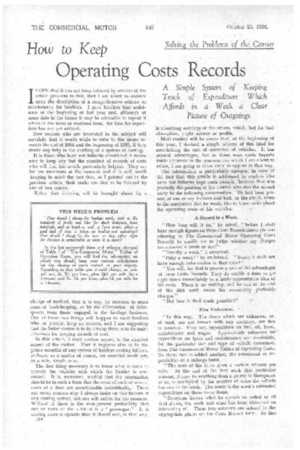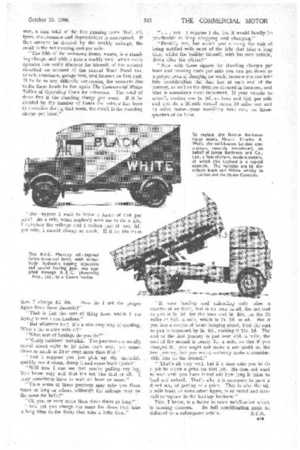How to Keep Solving the Problems Of the Carrier
Page 52

Page 53

If you've noticed an error in this article please click here to report it so we can fix it.
Operating Costs Records
A Simple System of Keeping Track of Expenditure Which Affords in, a Week a Clear Picture of Outgoings IHOPE that it has not been inferred by readers of the article previous to this, that I am about to embark upon the description of a comprehensive scheme of accountancy for hauliers. I gave hauliers that assistance at the beginning of last year and, although at some date in the future it may be advisable to repeat it either-in the same or modified form, the time for repetitithr has not yet arrived.
New readers who are interested in the subject will certainly find it worth while to refer 'to the issues towards the end of 1934 and the beginning of 1935, if they desire any help in the drafting of a system of costing.
It is those who have not hitherto considered it necessary to keep any but the scantiest of records of costs who will find this article particularly helpful. They are far too numerous at the moment and it is well worth keeping in mind the fact that, as I pointed out in the previous article, their ranks are due to be thinned by one of two means.
Either that thinning will be brought about by a change of method, that is to say, by recourse to some form of book-keeping, or by the elimination of delinquents from those engaged in the haulage business. One of those two things will happen to most. hauliers 'who, at present, keep no records, and I am suggesting that the better course is to be among thbse who do make provision for keeping records of cost.
In this article, I shall confine myself to the simplest aspect of the matter. That it-happens also to be the prime essential of any system of haulage costing follows, perhaps, as a matter of course, for essential needs are, as a rule, simple ones.
The first thing necessary is to know what it costs to operate the vehicles with which the haulier is concerned. it is, moreover, needful that the information should be in such a form that the costs of each of several units of a fleet are ascertainable individually. There are many reasons why I always insist on this feature in any costing system, but one will suffice for the moment. Without it there is the ever-present probability that one or more of the vehicles is a "passenger." It is costing more to operate than it should and, in that way, Fits is absorbing earnings of the others, which, but for that absorption, might appear as .profits.
Most readers will be aware that, at the beginning of this year, I devised a simple scheme of this kind for ascertaining the cost of operation of vehicles. It has several advantages; but as these were quite happily made apparent in the conversation which I am about to relate, I am going to allow them to appear in that way.
The information is particularly apropos, in .view of the fact that this article is addressed to readers who have not hitherto kept costs records, because that. was precisely the position of the haulier who was the second. party to the following conversation. He had been present at one of my lectures and had, as the result, come to the conclusion that he would like to know more about the operating costs of his vehicles.
A Record in a Week.
"How long will it be," he asked, "before I shall have enough figures on these Costs Record sheets (he was referring to The Commercial Motor Operating Costs Record) to enable me to judge whether my charges are showing a profit or not?"
"Exactly a week," I answered.
"Only a week!" he exclaimed. "Surely I shall not have enough information in that time.?"
"You will, for that is precisely one of the advantages of these Costs Records. They do enable a man to get right down immediately to a fairly approximate idea of his costs. There is no waiting, and he can at the end of the first week assess his reasonably profitable charges."
" But how is that made possible?"
Five Unknowns. -•
" In this way. The items which are unknown; or, at least, are not known with any accuracy, are five in number. They are, expenditure on fuel, oil, tyres, maintenance and wages. Approximate estimates for expenditure on tyres and maintenance are obtainable, for the particular size and type of vehicle concerned, from The Commercial Motor Tables of Operating Costs. To these two is added another, the assessment of depreciation on a mileage basis. "The sum of the three gives a certain amount per mile. At the end of the first. week that particular amount, it may be anything from a penny to threepence or so, is multiplied by the number of miles the vehicle has run in the week. The result is the week's estimated expenditure on those three items.
"Everyone knows what he spends on petrol or oil" fuel during the week and what has been disbursed on lubricating oil. These two amounts are entered in the appropriate places on the Costs Record form. In that way, a sum total of the five running costs (fuel, oil, tyres, maintenance and depreciation) is ascertained. If that amount be divided by the weekly mileage, the result is the net running cost per mile.
" The fifth of the unknown items, wages, is a standing charge, and with it goes a Weekly total, which every operator can easily discover for himself, of the amount absorbed on account of the annual Road Fund tax, vehicle insurance, garage rent, and interest on first cost. If he be in any difficulty concerning the amounts due under these heads he has again The Commercial Motor Tables of Operating Costs for reference. The total of these five is the standing charge per week. If it be divided by the number of hours the vehicle has been in operation during that week, the result is the standing charge per hour."
then I charge £2 10s. How 'do I get the proper
figure from these Records?"
"That is just the sort of thing from which I am trying to wean you hauliers."
"But whatever for? It's a nice easy way of quoting. What's the matter with it?"
"What sort of haulage do you do?"
"Mostly builders' materials. The journeys are usually round about eight to 10 miles each way, but sometimes as much as 20 or even more than that."
"And I suppose you just pick up the material, quickly run it along, dump it and come back again?"
"Well now I can see that you're pulling my leg. You know very well that it's not like that at all. I may sometimes have to wait an hour or more."
"Then some of these journeys may take you three times as long as others, although the mileage may be the same for both?"
"Oh yes, or even more than three times as long." And yet you charge the same for those that take a long time as for those that take a little time." If . yes. I suppose I do, but it would hardly bc
practicable to keep chopping and changing."
"Possibly not, but aren't you running the risk of being saddled with most of the jobs that take a long time'' whilst the builder himself, with his own vehicle, looks after the others?"
"Now with these figures for standing charges per hour and running costs per mile you can get down to a proper basis of charging for work, because you can take into consideration the time lost at each end of the journey, as well as the distance covered in between, and that is sometimes most important. If your vehicle be actually costing you is. 9d. an hour and 3-id. per mile and you do a 20-mile runI mean 10 miles out and 10 miles home—your travelling time may be threequarters of an hour.
"If your loading and unloading only takes a quarter of an hour, that is an hour in all, the net cost to you is is. 9d. for the hour and 5s. 10d. for the 20 miles at 34d. a mile, which is 7s. 7d. in all. But if you lose a couple of hours hanging about, then the cost to you is increased by 3s. 6d., making it 11s. 1d. The cost of the first journey is just over 4/d. a mile; the cost of the second is nearly 7d. a mile, so that if you charged 6d. you might not make a net profit on the first journey, but you would certainly make a considerable loss on the second."
" That's all very well, but if a man asks you to do a job he wants a price for that job. He does not want to wait until you have found out how long it takes to load and unload. That's why it is necessary to have a direct way of getting at a price. That is why the ad. a mile basis, or some other figure, is so useful and difficult to replace in the haulage business."
This, I know, is a factor in rates stabilization which is causing concern. Its full consideration must be
deferred to a subsequent article. S.T.R.




























































































